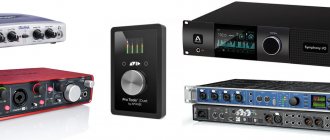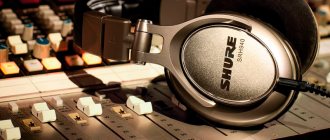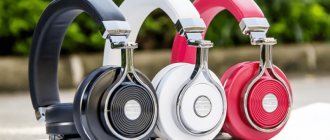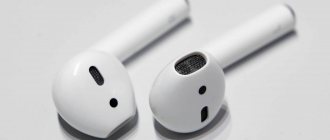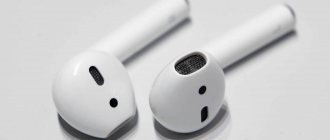Updated: 02/24/2021 18:35:12
Expert: Bogdan Shevchuk
*Review of the best according to the editors of expertology.ru. About the selection criteria. This material is subjective in nature, does not constitute advertising and does not serve as a purchase guide. Before purchasing, consultation with a specialist is required.
Like almost any other type of electronics, headphones can be quite clearly divided into two large groups - for leisure and for work, that is, studio ones. And studio headphones differ from any others in that, by definition, they are subject to increased requirements, as well as a number of fundamental requirements for both functionality and form factor. The Expertology editors, together with analysts from the rankquality.com service, have prepared for you a review of the most remarkable models of studio headphones at the beginning of 2022 with comments and descriptions from specialized experts.
How to choose studio headphones
To begin with, let’s briefly look at the criteria of what kind of headphones can be considered studio headphones, what tasks they can (or cannot, depending on the type and model) perform, what possible internal classifications exist, and what you should be guided by when choosing headphones for yourself.
What are studio headphones?
So, studio headphones are those very professional or, as they are also called, monitor headphones that are designed specifically for work - mixing, mastering, monitoring and other studio tasks.
Here you need to clearly understand that studio headphones are no better or worse than regular ones, even the most expensive ones. It's just a completely different type of device. The fact is that in studio headphones the sound is in no way embellished - there are no “juicy” bass so beloved by many, no perky high frequencies, and no wide stage. They do not smooth out or embellish sound defects in any way. Their task is to convey honest sound without embellishment, smoothly, in detail and naturally. That is, using them for leisure is frankly boring. This is a working tool, and not a gadget for entertainment.
What types of studio headphones are there?
There are quite a few conventional classifications of studio headphones, but the very first thing that needs to be taken into account when choosing is the “degree of openness”. This conventional term refers to three large groups of devices - open, semi-open and closed studio headphones. In terms of size, almost all studio headphones are full-size.
- Closed headphones are the most popular type of studio headphones, although in principle they have a specific purpose - directly for sound recording. They completely cover the ears and fit snugly to the head, but this is not the main thing. The main thing is that they have no external openings, and the sound is reproduced in an isolated, enclosed space - hence the name. Their task is to cut off as many extraneous external sounds as possible and prevent the sound of the recorded track from breaking through, thereby losing some of the important information about the nature of the sound.
- Open-back headphones allow some of the sound to escape through the gaps between the ear and the ear cup, as well as through straight holes in the body. This solution is optimal for listening to music while mixing tracks. Open-back headphones typically have a wide frequency range and flat frequency response. Their common drawback is obvious - the sound is audible not only to the operator, but also partly to people nearby. This is uncomfortable in itself, but sometimes it can create quite fundamental obstacles, say, for musicians playing particularly loud instruments.
- Semi-open headphones are a kind of compromise between the first and second. Developers of such models are trying to combine the advantages of open and closed types, and at the same time neutralize their disadvantages. This happens with varying degrees of success, so semi-open headphones have a narrower target audience - DJs, semi-professional sound engineers, TV cameramen, radio hosts.
Let us immediately emphasize that from a purely technical point of view, the term “half-open” is not entirely correct, since all open-back headphones are to some extent “half-open”, but since this terminology has firmly taken root, we will also use it.
Characteristics of monitor devices
To decide on the best monitor headphones, you need to know the characteristic features of the models that you need to pay attention to before purchasing.
The main ones are:
- Sensitivity. It depends on the sizes of the cores used in the structures. Sensitivity is the proportion between the strength of reproduced sounds and input signals, which are expressed in power and voltage. The product to be selected must have a sensitivity of 90 decibels or more.
- Frequency range. This is a parameter for determining sound quality, which is located in the frequency range 20 - 19000 hertz. At the same time, a wider range implies better sound reproduction; for professional models they are in the range of 5-60000 Hz, and even higher - up to 125 kHz.
- Impedance is a characteristic related to the electrical resistance of headphones. The higher it is, the better the quality of the work. In a professional device, the impedance is up to hundreds of ohms, while in a household device it is no more than several tens.
- The frequency response should only be linear. On the graph it is represented in green, with the following images extending from it: yellow – live sound, blue connections are intended for the performer’s sound system, orange indicates the sound of hissing and whistling sounds.
- The diameter of the membrane affects the clarity of the sound - as it increases, the sound becomes crisp and clear. In full-size systems, membranes of at least 30 mm are installed to achieve ideally deep, clear and rich sound.
- The power of the systems ranges from one mW to five thousand mW. Studio headphones have a power of several hundred milliwatts.
- The harmonic distortion coefficient is responsible for the characteristics of pure and clear sound. For professional systems it is no more than 0.5%.
When considering headphone models, it makes no sense to single out just one of all the characteristics provided. To evaluate a product you need to take a comprehensive approach.
Creating music tracks is quite a difficult job. Patience, attentiveness, and concentration are important here. Various voices and noises from the outside world affect the quality of work, so choosing the right headphones for work from a wide variety of devices is quite difficult.
Products with closed bowls suppress all nearby noise and prevent musical sounds from penetrating into the environment. This is important because when performing work, no one will be able to prevent the operator from recording, and the operator will not interfere with anyone.
If your work requires conditions in which you need to be able to hear everything that is happening near the operator, and you also need to be able to hear music tracks, you can purchase headphones with open external cups. Thanks to them, you can hear everything that is happening around, and also have air ventilation, which is useful for the ears during long work.
The choice of professional devices must be taken seriously; they differ significantly from conventional models in their set of characteristics, functionality, and cost. The main purpose of studio headphones is mixing a soundtrack, mastering, checking the quality of sound.
Before purchasing headphones, you need to pay attention to popular models from well-known manufacturers and consider the strengths and weaknesses of each product.
Let's consider models of studio devices that are used for various professional purposes, where closed products are used for recording tracks, and open ones are used for mixing.
Rating of the best studio headphones
| Nomination | place | Name of product | price |
| The Best Open-back Studio Headphones | 1 | Sennheiser HD 559 | 5 959 ₽ |
| 2 | Beyerdynamic DT 990 Pro | 11 344 ₽ | |
| 3 | Ultrasone PRO 2900i | 14 990 ₽ | |
| 4 | AKG K 712 Pro | 16 140 ₽ | |
| The Best Semi-Open Studio Headphones | 1 | AKG K240 Studio | 5 435 ₽ |
| 2 | Fostex T50RP MK3 | 11 500 ₽ | |
| 3 | Beyerdynamic T1 | 49 990 ₽ | |
| The best closed-back studio headphones | 1 | Sony MDR-7506 | 6 830 ₽ |
| 2 | Shure SRH840 | 8 005 ₽ | |
| 3 | AKG K 271 MK II | 9 720 ₽ | |
| 4 | Sennheiser HD 280 Pro | 6 074 ₽ | |
| 5 | Beyerdynamic DT 770 Pro | 11 067 ₽ |
Open type of devices for mastering and mixing
Let's look at products that are focused on mixing and mastering sounds.
Sennheiser HD 650
Sennheiser's wired full-size open ear headphones fit comfortably on top of your ears and do not put pressure on them. The device clearly reproduces the upper tones of musical works, but for low sound you need to connect an amplifier.
Dynamic headphones for mixing music operate in the range of reproduced frequencies from 10 to 41000 Hz, their impedance is 100 Ohms. They have a sensitivity of up to 103 dB and a maximum power of up to 500 mW.
For connections there are the necessary connectors, removable cables and cords.
The voice coil was made of aluminum, and the ear pads were covered with soft silk. The back surface of the cups is covered with copper metal mesh.
Country of origin: Ireland.
Cost - 16,200 rubles.
Sennheiser HD 650
Advantages:
- very detailed, clear sound;
- a real professional tool;
- excellent frequency range;
- high-quality assembly;
- very durable;
- elegant, original look;
- comfortable to wear;
- durable, replaceable cable;
- affordable price.
Flaws:
- poor equipment;
- The cable fastening system fails over time.
Beyerdynamic DT 990 Pro
Dynamic, open devices with a frequency range of 5 - 35000 Hz, with an impedance of 250 Ohms, sensitivity - 96 decibels, maximum power of 100 W. The open design significantly expands the sound threshold of music, promoting surround and airy sound. Demonstrates fairly accurate tonal reproduction with bright high-frequency sound, detailed, dense mid-range sound and elastic, fast bass.
For professionals, this type of stereo phone is one of the best for working in studios, and for amateurs – for listening to music at home.
Country of origin: Germany.
Cost: 13,990 rubles.
Beyerdynamic DT 990 Pro
Advantages:
- clear, light sound;
- brightness of high and mid tones;
- wide stage, spacious bass;
- excellent assembly;
- velor ear pads;
- tight fit;
- budget price.
Flaws:
- poor sound isolation;
- sibilants skip;
- not universal;
- sometimes difficult to use for mixing.
Ultrasone PRO 2900i
Dynamic wired open devices with 40 mm drivers, impedance - 40 Ohms, frequency range - from 6 to 42000 Hz. The sound pressure is 96 decibels. The technical performance of the product is impeccable; high technologies are used related to:
- Mylar speakers coated with titanium;
- neodymium magnets;
- using ULE technology with protective plates made of special metal.
Velor tips are installed on the ear pads, and the structure itself can be folded before transportation and in this form takes up very little space.
The product is highly recommended in professional circles; it works well with different types of music.
Country of origin: Germany.
Cost - 14990 rubles.
Ultrasone PRO 2900i
Advantages:
- natural sound;
- clear, distortion-free sound;
- reliable, practical design;
- high-quality assembly;
- comfortable fit;
- ease of transportation;
- inexpensive.
Flaws:
- fixed cable;
- a strong amplifier is required;
- You need warming up, good sources of sound and recordings.
The Best Semi-Open Studio Headphones
The second selection in the review of the best studio headphones according to Expertology are the so-called semi-open headphones. As we have already indicated above, this term is extremely conditional and, from a technical point of view, even incorrect. But due to the fact that such headphones still have a number of differences from open and closed in an attempt by manufacturers to take the advantages of both, we will also accept this established terminology.
AKG K240 Studio
Rating: 4.9
If in the previous selection AKG brand headphones were the most expensive, then the model that fell into this review category, on the contrary, is the most inexpensive of all. There are parallels in design with the K 712 Pro, but otherwise these models differ, and quite significantly.
AKG K240 Studio is very similar in format and dimensions to the previous model, while the headphones also weigh very little - 240g. The materials are dominated by high-quality plastic and eco-leather. The headphones are full-size, dimensional and do not have a foldable design, which is not very good, but in this case, users do not complain about this circumstance.
Let us highlight the main technical characteristics. Dynamic type headphones reproduce sound vibrations in the range from 15 to 25,000 Hz. The impedance is 55 ohms. Sensitivity - 101dB. Maximum power – 200 mW. Harmonic coefficient - 0.3%. Sound pressure – up to 104 dB.
Connect to one side via a detachable cable with a gold-plated standard 3.5mm plug. The kit includes an adapter for a 6.3mm jack format. The cable wire is made of oxygen-free copper.
The AKG K240 Studio is, in fact, an improved version of the discontinued AKG K240 Monitor, also a professional model. The Studio version received new XXL membranes, with which the headphones sounded even more natural, accurately conveying all the nuances of the material. The only point is that to fully unlock the potential, you still need an amplifier, and preferably not the most modest one. Otherwise, with a high probability, the headphones will “cut” the highest frequencies.
Advantages
- accurate reproduction of the sound of the material;
- high-quality materials and assembly;
- light weight;
- detachable cable;
- high-quality XXL membranes.
Flaws
- You need a good amplifier, otherwise there will be no accurate transmission of high frequencies.
Fostex T50RP MK3
Semi-open headphones of the simplest type - plastic cups attached to solid metal arches - amaze with the high resolution reproduction of complex symphonic works. They are considered the cheapest isodynamic models. Price - 12 thousand rubles.
Pros:
- Two detachable cables are included, as in the Audio-Technica ATH-M50x, one with a 3.5 mm connector, the other with a 6.3 mm connector.
- Isodynamic emitters.
- Easy and fast feeding, impeccable macrodynamics.
Minuses:
- The headband is very rigid and unusual, although it fits any head size.
- The feature of an isodynamic driver is both a plus and a minus. Places enormous demands on the power and quality of the reproducing clock and recording.
The main disadvantage of the model is discomfort: the headphones are very “tight” and require powerful amplification. As an isodynamic probe, it’s cheap. But in terms of bass and treble sound quality, it is inferior to the Audio-Technica ATH-M50x and Shure SRH840. Well suited for listening to large-scale, rich works. The most advantageous part of the model is the mid frequencies.
Reviews on Yandex.Market

